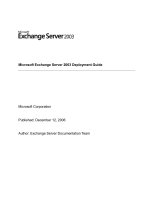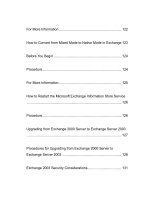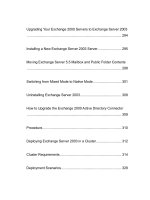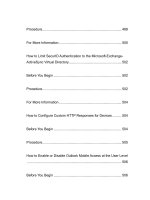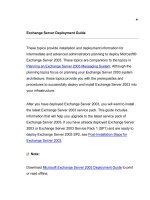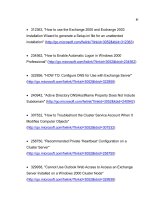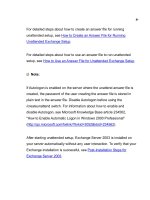Microsoft Exchange Server 2003 Deployment Guide- P13 doc
Bạn đang xem bản rút gọn của tài liệu. Xem và tải ngay bản đầy đủ của tài liệu tại đây (241.74 KB, 10 trang )
121
you want to perform. These configurations are normally set when you
perform a manual Exchange 2003 installation on one of your servers.
Before You Begin
You can run unattended setup for the following procedures:
Installing the second to nth Exchange 2003 server in your
organization.
Installing Exchange 2003 System Management Tools.
Running DomainPrep.
You cannot run unattended setup for the following procedures:
Installing the first Exchange Server 2003 server in your organization.
Installing Exchange Server 2003 in a Windows server cluster.
Installing Exchange Server 2003 in a mixed-mode environment (for
example, Exchange 5.5 and Exchange 2003).
122
Performing any maintenance tasks (for example, adding or removing
programs, re-installing Exchange, or upgrading from Exchange 2000).
Procedure
To use an answer file for unattended Exchange setup
1. On a server to which you want to install Exchange 2003 in
unattended mode, insert the Exchange CD into your CD-ROM drive.
2. From a command prompt, type E:\setup\i386\setup /unattendfile
D:\myanswerfile.ini, where E is your CD-ROM drive, D
is your system
drive, and myanswerfile.ini represents the name of the answer file.
For More Information
For detailed steps about how to create an answer file, see How to
Create an Answer File for Running Unattended Exchange Setup.
For more information about unattended setup, see Microsoft
Knowledge Base article 312363, "How to use the Exchange 2000 and
Exchange 2003 Installation Wizard to generate a Setup.ini file for an
unattended installation,"
(
123
How to Convert from Mixed Mode to Native Mode in Exchange
An organization that is running in mixed mode can accommodate all
versions of Exchange Server. An organization that is running in native
mode can contain only Exchange 2000 Server or later computers; new
Exchange Server 5.5 (or earlier) computers cannot be introduced into the
organization. By default, Exchange 2000 Server and Exchange Server
2003 are installed in mixed mode.
You can convert an Exchange organization to native mode after all of the
servers are upgraded to Exchange 2000 or later, and earlier release
restrictions no longer apply. You cannot switch to native mode until you
either upgrade or decommission Exchange Server 5.5 (or earlier)
computers.
The following are some of the features of Exchange native mode:
Routing groups can consist of servers from multiple administrative
groups.
Ability to move servers between routing groups.
Simple Mail Transfer Protocol (SMTP) is the default routing protocol.
124
Before You Begin
Note:
Before you can convert an Exchange organization from mixed mode to
native mode, all of the computers in the organization must be running
Exchange 2000 or later.
Important:
After converting the Exchange organization to native mode, you
cannot change back to mixed mode. This is a one-time conversion,
and you must fully understand the results before you proceed.
Procedure
To convert from mixed mode to native mode in Exchange
1. Open Exchange System Manager.
2. In the console tree, right-click the organization that you want to
switch to native mode, and then click Properties.
125
3. In <Organization Name> Properties, under Change operation
mode, click Change Mode.
4. In the warning dialog box, click Yes if you are sure that you want to
permanently switch to native mode. Click Apply to accept your new
Exchange mode.
For More Information
For more information about mixed mode and native mode for Exchange
Server, see the following Microsoft Knowledge Base articles:
270143, "XADM: Mixed Mode vs. Native
Mode"(
327779, "How To Convert from Mixed Mode to Native Mode in
Exchange"(
272314, "XADM: Preparing a Mixed Mode Organization for Conversion
to Native
Mode"(
126
How to Restart the Microsoft Exchange Information Store Service
The core data storage repository for Microsoft Exchange Server 2003 is
the Microsoft Exchange Information Store service, which contains both
mailbox store and public folder store data. The Microsoft Exchange
Information Store service uses a database engine called Extensible
Storage Engine (ESE), which is a transaction-based database
technology.
In some troubleshooting instances or when moving from mixed to native
mode, you may need to restart the Microsoft Exchange Information Store
service.
Procedure
To restart the Microsoft Exchange Information Store service
1. On the Start menu, click Run, type services.msc, and then click
OK.
2. In the Results pane, find the Microsoft Exchange Information
Store service.
127
3. Right-click the service, and then click Restart.
Upgrading from Exchange 2000 Server to Exchange Server 2003
This topic provides instructions for upgrading your organization from
Microsoft® Exchange 2000 Server to Exchange Server 2003. Specifically,
this topic will:
Provide you with the requirements necessary to upgrade from
Exchange 2000 Server.
Provide you with information about running Exchange Server 2003
Deployment Tools.
Provide you with information about improvements in Exchange Server
2003 Setup.
Show you how to run ForestPrep.
Show you how to run DomainPrep.
128
Show you how to run Exchange Setup to upgrade your organization.
Show you the Exchange 2000 Server tuning parameters you must
remove after performing the upgrade.
Procedures for Upgrading from Exchange 2000 Server to Exchange
Server 2003
After ensuring that your organization meets the necessary prerequisites,
the procedures referenced in this topic guide you through the deployment
process. This process includes upgrading your Microsoft Active
Directory® directory service forest to the Exchange 2003 schema, and
then upgrading your Exchange 2000 servers to Exchange Server 2003.
Table 1 lists the required permissions or roles for the procedures
referenced in this topic.
129
Table 1 Procedures referenced in this topic and corresponding
permissions
Procedure Required permissions or roles
Enable Windows® 2000 Server or
Windows Server™ 2003 services
See Windows 2000 or Windows
Server 2003 Help
Run ForestPrep on a domain
controller (updates the Active
Directory schema)
Enterprise Administrator
Schema Administrator
Domain Administrator
Local Machine Administrator
Run DomainPrep
Domain Administrator
Local Machine Administrator
130
Procedure Required permissions or roles
Remove Mobile Information Server
Exchange 2000 Event Source
Microsoft Mobility Administrator
Local Machine Administrator
Upgrade to Exchange Server 2003
on an Exchange 2000 Server in a
domain
Exchange Full Administrator role
applied at the organization level
Local Machine Administrator
Install Exchange Server 2003 on
additional servers in the domain
Exchange Full Administrator role
applied at the administrative group
level
Local Machine Administrator
For more information about managing and delegating permissions and
user and group authorities, see the Exchange Server 2003 Administration
Guide.
